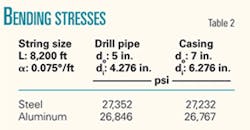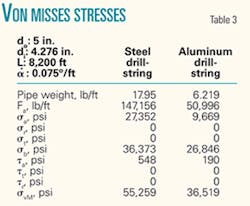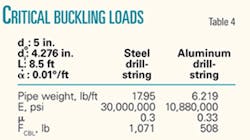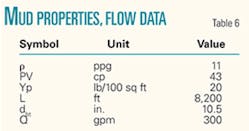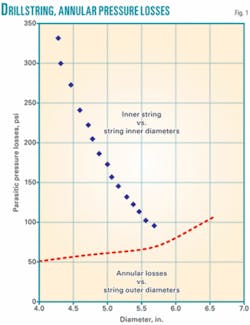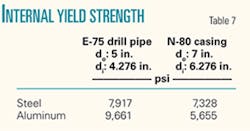This article examines the difference in axial stresses of aluminum and steel tubulars during drilling and concludes that aluminum tubulars can reduce cost and extend the reach of drilling operations.
The cost of drilling depends on the size and weight of the equipment employed to drill the well. Density of tubulars is an important parameter that has significant impact on the capacity and size of drilling equipment required. It may be possible to reduce drilling costs by employing oil well tubulars made of materials lighter than steel.
It is well known that aluminum is widely available and less expensive than steel. So for the purpose of reducing drilling costs, why not use aluminum tubulars in oil well drilling?
The choice of material dictates both the tubular stresses and strength. This article discusses the technical viability of employing aluminum-based tubulars in oil well drilling and assesses the tubular stresses expected during common drilling operations with aluminum and steel tubulars.
Design
When designing a drilling tool and components, engineers take anticipated loads and stresses into consideration and select components to meet or exceed the maximum anticipated stresses.
The required strength of oil well drilling equipment depends primarily on maximum anticipated stresses and safety factors. These stresses include tension, compression, pressure, bending, and torsion.
Axial stress (tension and compression) is important, either directly or indirectly, in a number of design aspects. For instance:
- The hanging weight of casings and drillstrings sets the requirements for axial strengths of downhole tubulars and the sizes of the drilling lines that are strung through the crown and traveling block.
- Derrick legs are in compression during drilling due to hook loads that are also a function of tubular weight and dynamic running conditions. Project staff must determine the maximum amount of compression acting on a derrick leg to choose the required derrick capacity.
- Axial stress is an important input to correct tubular ratings for collapse and burst.
- The use of lighter pipe, with consequently less axial stress, allows for larger diameter drillstrings to be selected, reducing parasitic pressure losses and providing greater hydraulic horsepower to the BHA components and bit.
- The fatigue failure of drill pipe resulting from rotating tubulars in doglegs or under buckling conditions for extended periods under stress is proportional to the axial stress magnitude and type.
The design of lightweight aluminum-based drill pipe (LADP), drilling practices, and analytical studies have shown that LADP strings have technical and technological benefits when compared with steel strings. LADP may reduce the cost of extended reach drilling projects and permit longer displacements.1
The objective of this study is to investigate the changes in magnitude of axial stress when aluminum or steel tubulars are used in the drilling process.
It shows the advantages and disadvantages of using aluminum-based composite materials by comparing the results of stress and strength requirements of aluminum and steel-based materials in different drilling aspects, such as derrick loads, bending loads, buckling loads, stress and strain, and hydraulics.
Derrick loads
The derrick supports the weight of drillstring, casing strings, drilling lines, blocks, and tackle. The sum of all these loads is the derrick load. Total derrick load is not shared equally by each leg. One leg (with the dead line anchor attached) will always support more of the total load than the three others. Conservatively, the equivalent derrick load, equivalent to four times maximum leg load, generally determines the required minimum derrick capacity.
Equivalent derrick load depends on hook load and the number of drilling lines. It can be calculated with Equation 1.2
For comparison, we determined the equivalent derrick loads for aluminum and steel drillstrings (Table 1). The table shows that equivalent derrick loads can be reduced 65% if aluminum is used for drill and casing strings instead of steel in an 8,200 ft well.
Bending stresses—yield
Hole curvature is a significant wellbore parameter that contributes to drill pipe failures in deviated boreholes. There are two types of drill pipe failure in curved holes: yield and fatigue. Yield occurs as soon as von Misses stress3 exceeds the yield strength of pipe. It can occur even in static conditions. To avoid this type of failure, engineers make sure the maximum anticipated von Misses stress is less than the yield strength of every tubular.
Equation 2 is based on the maximum strain energy of distortion and this equation can be used to determine von Misses stress.3
Bending stress is at a maximum at the outer surface of pipes, as shown by Equation 3.4 5 As we see from Equation 3, bending stress is a function of the hanging weight and the modulus of elasticity, E.
Table 2 provides details of a sample problem that illustrates the difference in bending stresses in aluminum and steel strings. In this example, a dogleg at the top of the hole has a severity of 7.5º/100 ft. The data show that bending stresses are similar for both strings. This is because the reduction in axial force in aluminum strings is offset by the reduction in modulus of elasticity.
Experience has shown that as much as 60% of the hook load comes from drag forces, primarily related to the weight of the drillstring. As the weight of drillstring decreases, so does the drag force. This will influence bending stresses as well. One can expect much smaller bending stresses during trips with aluminum drillstrings due to much smaller drag forces on aluminum, or smaller Fa in the previous equation.
Similar to bending stress, axial stress and axial shear stress are also weight-dependent parameters. Equations 4-9 are used to determine these two stresses.
Table 3 shows another example that illustrates the difference in aluminum and steel strings based on von Misses stresses. In this instance, note that the required minimum yield strength of drill pipe in a steel drillstring is 55,259 psi, whereas the yield required for aluminum is only 36,519 psi.
Fatigue failure
Another consequence of borehole curvature is fatigue failure that shows up under dynamic conditions when pipes are rotating. Fatigue failures can even occur in boreholes in which the von Misses stress is less than the pipe yield strength. It is a time-dependent phenomenon.
Two borehole parametersdogleg severity and tensionplay important roles in determining fatigue life of drill pipe. Fatigue life shortens as the dogleg severity and tension increase. Using aluminum pipe in drillstrings reduces tension considerably and it’s reasonable to predict a longer string fatigue life.
Buckling loads
Drillstrings buckle when compression exceeds critical buckling load. Critical buckling load is defined as the load at which tubulars have no resistance against lateral displacement. Even though lateral displacement of pipe during the initial stages of buckling is terminated by the clearance between the wellbore and pipe, some researchers believe this initial buckling, usually 2D, is followed by 3D helical buckling.6 Therefore, compression should be kept below the critical buckling load.
In order to determine critical buckling loads of aluminum and steel pipes, researchers studied 2D, non-linear buckling using finite-element analysis (Table 4).6 Predictably, steel pipe can handle twice as much compression as aluminum without initiating buckling.
Stress, strain
The relation between stress and strain is expressed by Hooke’s law, shown in Equations 10-12.
One might expect larger stretch in aluminum strings as compared with steel pipe. However, because aluminum strings weigh less, their stretch will not be as large as expected. Table 5 illustrates that both aluminum and steel materials stretch close to the same amount for a given pipe length.
Frictional pressure losses
Parasitic pressure losses in downhole tubulars due to fluid flow depend on five main parameters: pipe length, diameter, flow rate, density, and viscosity. With all other parameters constant, pressure losses can be determined as a function of pipe diameter. Fig. 1 illustrates pressure losses vs. OD of pipe using the data from Table 6.
With the rest of the parameters held constant, pressure losses increase as outer diameter increases. This is simply because of decrease in hole-pipe clearance.
To produce the data necessary to generate Fig. 1, we determined the pressure losses for pipe with outer diameters from 5 in. to 6.5 in., in 0.1-in. increments. We see that the annular pressure drop increases to 105 psi from 51 psi.
Fig. 1 also illustrates pressure losses for different internal pipe diameters. Contrary to the previous case, as the internal diameter increases, pressure losses decreases. This can be attributed to smaller Reynolds numbers at larger diameters.
In this example, increasing the internal diameter to 5.776 in. from 4.276 in. caused a reduction in pressure loss to 88 psi from 332 psi.
An important observation here is that the overall effect of increasing pipe inner and outer diameters is a decrease in cumulative pressure loss. In this case, overall pressure drop was 190 psi (about 42%).
Tubular sizes are generally specified after examining stress loads, derrick load capacity, and drilling fluid hydraulics. As mentioned above, using aluminum tubulars in place of steel can significantly reduce derrick loads and tubular stresses. This allows the use of larger diameter pipes that will have lower parasitic pressure losses and satisfy the required hydraulics with a smaller slush pump.
Pressure loading
Any analysis of pressure loading on pipe must consider internal yield pressure, collapse pressure (Lame’s equation), and plastic collapse pressure.
Internal yield pressure is the magnitude of internal pressure that leads to the internal yield failure (burst) of a pipe under axial stress, calculated with Equations 13-14.
Table 7 shows the differences in internal yield pressure of aluminum and steel pipes. Aluminum and steel pipes have different adjusted yield strengths. For this case, the yield strength of N-80 steel casing is considered to be 80,000 psi and the strength of aluminum-based alloy is 69,618 psi. The yield strength value of E-75 steel drill pipe is considered to be 75,000 psi.
Collapse pressure-API Bulletin 5C3 recommends four equations for computing the collapse pressure resistance of tubulars.7 The choice of equations is based only on the inside diameter to wall thickness (D/t) ratio of the tubular. The first equation is a theoretical equation based on the yielding of the inner wall of a tubular. It is known as Lame’s equation in the mechanics of materials.3
The second equation is empirical, derived from collapsing 2,488 tubes of three different grades: K-55, N-80, and P-110. API calls these values the “plastic collapse pressure” of tubes.
The third equation is an arbitrary equation generated by associating the plastic collapse equation with the elastic collapse. It holds no theoretical or empirical substance.
The last equation, Equation 15, is a theoretical equation based on the bifurcation of the wall of the tubular without yielding. Equation 15 includes the parameter σYPa, defined in Equation 16. In the example, we chose casing dimensions that allowed us to use the elastic collapse equation, as there is no empirical collapse equation for aluminum tubulars at this point.
Table 8 shows that an aluminum casing segment in suspension, with 8,200 ft of casing hanging from it, can resist up to 9,152 psi collapse pressure. Therefore, using aluminum casing in this hole is more favorable than using C-75 steel, as steel casing can only support 9,044 psi.
Buoyancy
The buoyancy factor of drillstring in mud is determined with Equation 17.
The buoyancy factor of aluminum drill pipe plunged into 10 ppg mud is 0.57, while the buoyancy factor of steel pipe in the same mud is 0.85. This is a positive attribute of aluminum; the weight of aluminum drillstring in 10 ppg mud is barely more than half of what it weighs in air.
Aluminum advantage
Using aluminum-based alloys in drillstring can reduce the need for more expensive, stronger drilling components for two main reasons:
- Lighter drillstring decreases the maximum anticipated stresses, such as the axial stress acting on casing and-or drillstrings, hook load acting on drilling lines, derrick loads acting on derrick legs, and bending stresses acting on downhole tubulars.
- The collapse strength of aluminum-based drillstrings is higher than that of steel strings. This is because collapse strength of casing is a function of the tension within them.
Quantitative analyses indicate that aluminum tubulars are superior to steel ones in different design cases. For example, equivalent derrick loads can be reduced 65% by using aluminum drill and casing strings instead of steel ones (Table 1).
Calculating von Misses stress for a curved well showed that the required minimum yield strength for aluminum pipes is 52% less than steel (Table 3). Results of stress and stretch calculations based on Hooke’s law proved that aluminum strings do not stretch more than steel strings under their own weight (Table 5). Collapse resistance of casings is determined with Lame’s theoretical equations for some d/t ratios. Table 8 shows that with 8,200 ft of casing hanging in the hole, aluminum casing has greater collapse resistance than C-75 steel casing.
As mentioned, by using an aluminum string we can employ tubulars with a larger outer diameter in place of smaller-diameter steel, since derrick loads and tubular stresses can be offset. This allows for lower parasitic pressure losses (Fig. 1).
On the other hand, quantitative analysis indicated that there are some disadvantages to using aluminum pipes. For example, critical buckling load for aluminum pipe is about 50% less than steel pipes (Table 4).
This means aluminum pipe can buckle into a helix more easily than steel pipe. A “lockup” condition may occur more frequently in aluminum tubulars. The internal yield strength of aluminum pipe is slightly less than steel when there is no tension acting on the tubulars (Table 7). We expect that as weight increases, this difference becomes more pronounced as the tension increases the internal yield strength of tubulars.
Results
The design of drilling components utilizes strength and stress material attributes and there are significant differences between aluminum and steel strings. When aluminum strings are substituted for steel, stresses are reduced and strength is increased in a number of drilling designs. For instance:
- Equivalent derrick loads can be reduced. This means operators can use a smaller rig and smaller diameter drilling line.
- Drillstring axial and bending stresses are lower due to the smaller buoyancy factor and smaller drag forces for aluminum. This means pipe can be run into higher-angle doglegs more safely.
- Von Misses stress can be reduced, which suggests fewer axial failures.
- Aluminum pipe stretch, under its own weight, is less than that of steel.
- Running larger-diameter aluminum pipe in place of smaller-diameter steel pipe can reduce frictional pressure loss in the wellbore during circulation. This results in a lower equivalent circulating density and requires a smaller pump.
- Collapse strength of casing can increase as weight decreases.
There are some disadvantages to using aluminum pipes as well. For instance, the burst strength of pipes is reduced as weight decreases, and the critical buckling load in aluminum pipes is less than that of steel pipes. This could be major drawback in extended reach drilling.
References
- Gelfgat, M., Basovich S.V., and Tikhonov, V.S. “Drillstring with Aluminum Alloy Pipes Design and Practices,” SPE/IADC 79873 Drilling Conference, Amsterdam, Feb. 19-21, 2003.
- Bourgoyne, A.T., MiIlheim, K.K, Chenevert, M.E., and Young, F.S., Applied Drilling Engineering, SPE Textbook Series, Vol. 2, 1986, Ch. 4.
- Timoshenko, S., Strength of Materials, Part I, Elementary Theory and Problems, New York: Van Nostrand Reinhold Co., 1958.
- Lubinski, Arthur, Althouse, W.S., and Logan, J.L., “Helical Buckling of Tubing Sealed in Packers,” Journal of Petroleum Technology, June 1962, pp. 655-670.
- Lubinski, Arthur, and Blenkarn, Kenneth A., “Buckling of Tubing in Pumping Wells, its Effects and Means for Controlling It,” Pet. Transactions, AIME, 1957, pp. 73-88.
- Akgun, Ferda, Gurakin, G., Mitchell, B.J., Euster, A.W., and Rahman, S.S., “Theoretical and Experimental Evaluation of Drill Pipe Stability Conditions in Slim Holes,” SPE 36405, Proc. Of the SPE Asia Pacific Oil and Gas Conf., Adelaide, Oct. 28-31, 1996, pp. 641-655.
- Bulletin on Formulas and Calculations for Casing, Tubing, Drill Pipe and Line Pipe Properties. API Bulletin 5C3, 5th Ed., July 1989, API Production Dept., 44 pp.
Based on and updated from two presentations: IADC/SPE Asia Pacific Drilling Technology Conf., Jakarta, Sept. 7-9, 1998 (IADC/SPE 47823-MS) and SPE Asia Pacific Oil & Gas Conf. and Exhibition, Perth, Oct. 12-14, 1998 (SPE 49957).
The authors
Ferda Akgun ([email protected]) is an associate professor in the department of petroleum engineering at the Petroleum Institute, Abu Dhabi. He has also served as a faculty member at UAE University, University of New South Wales, and Middle East Technical University. Akgun holds a BS (1982) from Middle East Technical University and a PhD (1989) from Colorado School of Mines, both in petroleum engineering. He is a certified WellCAP and IWCF instructor and a member of SPE.
Eric Maidla ([email protected]) is founder and partner of Slider LLC, which specializes in automated directional drilling technologies. He was vice-president of business development for Noble, 2001-04, and prior to that, worked in Australia for 7 years as the head of the drilling group at CSIRO, an Australian government research organization. In 1988, Maidla founded the petroleum engineering department at the State University of Campinas, Brazil. He holds a BS (1981) in mechanical engineering from Escola de Engenharia Maua, Sao Paulo; an MS (1985) and a PhD (1987), both in petroleum engineering from Louisiana State University, Baton Rouge. Maidla is a member of SPEm has served on the SPE books and managed pressure drilling committees since 2002, and has chaired various conferences and workshops.



